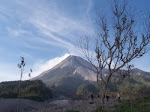 After the tsunami hit Aceh, Padang and the rest of West Sumatra were left unscathed, but the news induced great trauma in the people,” said Patra Rina Dewi, executive director of the Tsunami Alert Community (Kogami), a local nongovernmental organization.
After the tsunami hit Aceh, Padang and the rest of West Sumatra were left unscathed, but the news induced great trauma in the people,” said Patra Rina Dewi, executive director of the Tsunami Alert Community (Kogami), a local nongovernmental organization.The Dec. 26, 2004, Indian Ocean tsunami was the worst the world had seen in around 600 years, and Padang’s neighbor, Aceh, lost 170,000 people to the waves, making it the worst-hit area in the world. Just four months later, a 6.7-magnitude earthquake hit Padang, sending thousands of residents fleeing inland in fear of another tsunami. “Our first priority became to assuage the fears of the people,” Patra said. “They were scared because there was no information about when they had to run or what action they should take.”
Established in July 2005, Kogami has been working to instill a culture of disaster preparedness among Padang’s residents. Training people is a key component of its efforts. To achieve its aim — to reduce risks by strengthening capacity and decreasing vulnerability — Kogami has set up a number of programs, including educational programs for school students, educational material development, capacity building, disaster mitigation and surveys and assessments.
The organization includes 12 permanent staff members, 200 facilitators, who are all local volunteers, and an international team of geologists from Indonesia, Japan, Germany and the United States. “At the beginning, our knowledge about disasters was zero,” Patra said. “None of us had a background in disaster training. We came from engineering, farming and agricultural backgrounds.”
A San Francisco-based NGO called the SurfZone Relief Operation, which was already providing aid to Sumatra, wanted to set up an educational program for disaster preparedness. The local volunteers involved with SurfZone established Kogami.
Kogami chose to focus on Padang when it launched because the city has the largest population of people at risk of a major tsunami. Out of Padang’s 750,000 residents, 400,000 live or work by the sea, Patra said. Other areas surrounding the city that are under threat are the West Sumatra districts of Pesisir Selatan, Agam, West Pasaman, Padang Pariaman, the city of Pariaman and the Mentawai Islands. This year, Kogami has begun work with the people of Pesisir Selatan and Padang Pariaman, with support from the Mercy Corps.
At first, the organization had a difficult time connecting with the local community and government. “They weren’t ready to hear the word tsunami,” Patra said. “The government said we were preventing investors and tourists from coming here.” But Patra said doing nothing about the situation would in fact turn investors away.
Since 2005, a total of 61 schools have received trained for dealing with natural disasters. Starting from the first grade, children are taught how to prepare for earthquakes and tsunamis and what to do should they hit the region. “They have to know where it is safe to place the teacher’s desk, if it’s safe to place desks next to windows. They have to present a plan to the class,” Patra said.
In January 2009, a trial program to integrate disaster preparation into the curriculum began in 12 Padang schools. Education workshops are also held in villages to ensure a system is in place and that everyone has the necessary knowledge of disaster planning and evacuation strategies. Among their various activities, Kogami has mapped out evacuation routes. High-risk areas are zoned red, while low-risk areas are zoned yellow. “People can identify which the closest evacuation route is for them based on sector maps of the city,” Patra said.
Kogami has installed a preventive-measures group in each threat zone. The groups are made up of locals, who focus on disaster and emergency preparation in the red zones and the establishment of “3x24” emergency shelters in yellow zones. “We predict that help won’t come for times 24 hours and that local resources will have to be able to shelter casualties for that amount of time,” Patra said. Religious beliefs are often a challenge to Kogami. Patra said the local mind-set was often, “If Allah thinks we’re meant to die, we shall die.” Kogami is attempting to change this perception. “We need to break down this mentality because we need to try our best first, and then leave it to God.”
Note: a re-post from an article publish in the Jakarta Globe on May10, 2009
Image source: the Jakarta Globe





0 comments:
Post a Comment